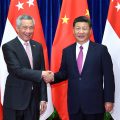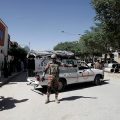An exhibition on an Allied POW camp run by the Japanese Army in China helps people better understand the WWII history and inspires reflection on wars, said visitors.
The Mukden POW camp in Shenyang held more than 2,000 Allied POWs who arrived from the Philippines by sea from 1942 to 1945 after the Bataan Death March. But this camp went unremembered for half a century and this history was not well known.
“It’s a wonderful reenactmentIt gives those of us who were born after World War II an understanding of what our soldiers went through,” said Anna Graves, a visitor to the ongoing exhibition Forgotten Camp in San Francisco.
Through 250 historic photographs and 42 pieces of duplicated artifacts, the exhibition, organized by the Site Museum of Shenyang POW Camp of WWII Allied Forces and China Daily, depicts the hardships endured by those POWs.
Graves said she had never heard of the camp but she was impressed by the resilience and camaraderie of the POWs, and their willingness to help each other and survive through it.
The exhibit had visited Liverpool, England, in 2015. It’s the second time it has traveled overseas. It’s important for the US public to learn about this history as most of the Allied POWs held at the Mukden camp were Americans, said Fan Lihong, director of the Site Museum of Shenyang POW Camp of WWII Allied Forces.
Jim Barnard, a resident of Berkeley, said he had learned a lot more after viewing the exhibit.
“I had heard about the brutality of the experience (of POWs). But I hadn’t heard about the trip by ship after the (Bataan) march,” he said.
The Japanese hell ships, which were used to transfer Allied POWs during the Pacific War, have the reputation for appalling living conditions and cruelty among the crew.
“It’s fantastic that the exhibit is here, so that people can have a real sense of what actually happened in the past,” said Norm Arslan, a visitor. “This brings to life in a real way that you simply cannot get by reading in the book. It makes the experience very real.”
Arslan said the photographs make the whole experience real. “When you see those photographs, it makes you feel you are right there. It’s the most powerful part of the exhibit,” he said.
The historical photographs on display are from the permanent collection of the Site Museum of Shenyang POW Camp of WWII Allied Forces. The photographs not only depict the history but also the lesser-known friendships that took root between the prisoners and the local Chinese workers, and the visit to the site by some of the former POWs in 2007.
“I’m grateful because it’s my parents’ generation who fought in this war. They lived with the pain of it all their lives,” said Graves with tears in her eyes.
“I think here, where life is rich, you can hardly imagine being in a war. We have to remember our past, and we have to remember wars happening all over the world, too, still now,” she said. “How unnecessary is war? Why can’t we work out things by talking and being fair to one another?”
The exhibition, which was scheduled to end in December, has been extended to March.



